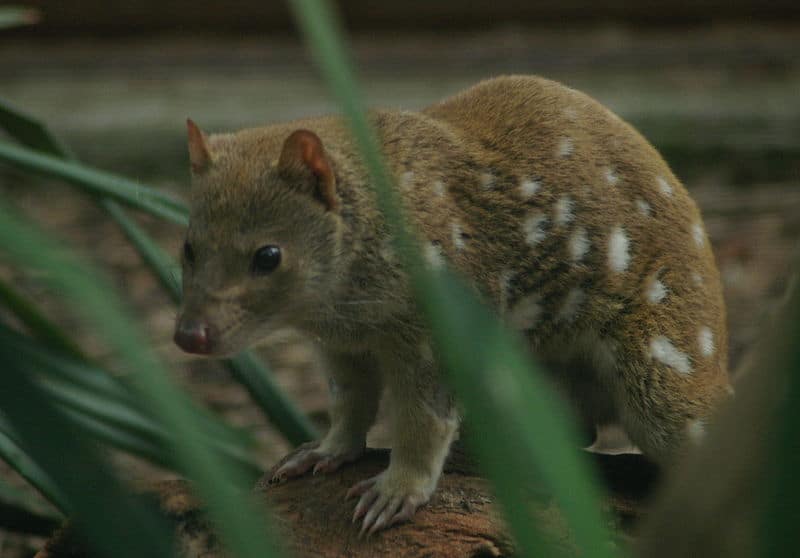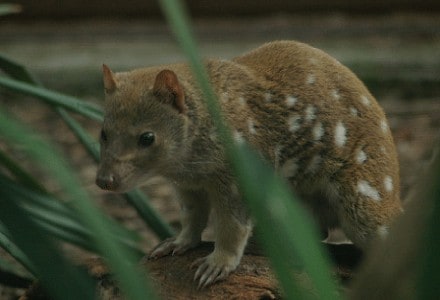
Tiger Quoll Facts
- The term Tiger Quoll serves as the common name for a truly amazing creation of Nature. Scientists, however, know it by a wholly different name. That’s because, among professional researchers, it’s generally referred to as the Dasyurus maculatus.
- Some local inhabitants of the range it inhabits also refer to it by yet another common name. That alternate term’s the name of Spotted Quoll. Regardless of which name one uses for it though, this marvel of evolution remains a most fascinating animal.
- This statement, perhaps surprising to some, holds true because the animal evolved as a carnivorous marsupial. It ranks as unusual due to one particular fact. That’s the fact that the animal represents one of only 40 such marsupials known to inhabit the earth.
- This interesting animal also stands out for its size. That’s because it ranks as the largest extant carnivorous marsupial in the region it inhabits. Though not the heaviest, the species nevertheless qualifies as the longest known such marsupial on earth.
- Within its zone of habitation, science considers it an apex predator. Biologists also recognize two known subspecies. For now, the IUCN lists the Tiger Quoll as Near Threatened. Sadly, it remains vulnerable to habitat loss and climate change.
Related Articles
Bandicoot Tree Kangaroo Quokka
Tiger Quoll Physical Description
Perhaps most notably, out of all the known species of quoll, the Tiger Quoll remains the largest. Like many other creatures, this marsupial also displays the trait of sexual dimorphism. In this particular case, that trait manifests itself in terms of sheer physical size.
In this species, that attribute displays itself in the fact that males attain significantly larger sizes. The much larger male of the species attains an average weight of roughly 7.7 lb (3.5 kg). The adult males also average about 36.6 in (93 cm) in the total head and body length.
The female of this fascinating species, meanwhile, attains a markedly smaller size. While this is a reasonably common characteristic among mammals, this creature takes it to a greater degree than some. This discrepancy manifests itself in terms of weight and length.
In point of fact, the female only attains an average body weight of about 4 lb (1.8 kg). The females further only average a head and body length of 31.9 in (81 cm). This size difference does, however, make it easier for researchers to distinguish the genders in the wild.
The tails generally grow longer than the head and body. The legs of the Tiger Quoll usually develop quite short in length. The coat also typically shows a brownish-red, with white spots. The underbelly, though, usually displays either an off-white or light gray in color.
- Kingdom: Animalia
- Phylum: Chordata
- Class: Mammalia
- Order: Dasyuromorphia
- Family: Dasyuridae
- Genus: Dasyurus
- Species: D. maculatus
Photographer: Pierre Pouliquin
CC License: https://bit.ly/3vL7vyD
Tiger Quoll Distribution, Habitat, and Ecology
To the surprise of few individuals, the fabulous Tiger Quoll evolved as endemic to a portion of the world already renowned for its amazing flora and fauna. That’s due to the fact that the amazing mammal originated in the eastern regions of the continent of Australia.
The species also impresses researchers for yet another reason. That’s because it can also tolerate a wide variety of habitats. The great majority of individuals most commonly appear in the relatively abundant areas of either eucalyptus forest or rainforest, however.
Although highly adaptable, the incredible animal does display a decided preference for where it spends the greater portion of its time. More precisely, the creature generally lives on the ground. The small but powerful marsupial can, and frequently does, climb trees, though.
Fortunately for it, this creates a limitation to the number of predators the Tiger Quoll faces. But species such as the Masked Owl and the Tasmanian Devil do prey upon it. Yet in turn, the astonishing carnivore appears to be extremely indiscriminate in its own choice of prey.
This perhaps gives it something of an evolutionary advantage. These prey include a wide variety of insects, snakes, lizards, small mammals, birds, rabbits, and wallabies, to name a few. Many individuals also prefer to scavenge large prey when it is available.
Species Sharing Its Range
Thorny Dragon Western Underground Orchid Mouse Spider
Check out our other articles on 5 Remarkable Asian Herbaceous Plants, Phallus Indusiatus, Kemps Ridley Sea Turtle, Kali Gandaki Gorge, Hyalinobatrachium dianae, Aye-aye

